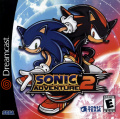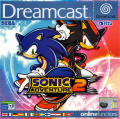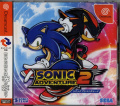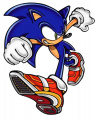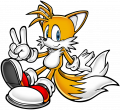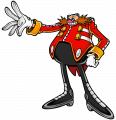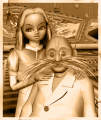Difference between revisions of "Sonic Adventure 2"
From Sonic Retro
| Line 95: | Line 95: | ||
===Production Credits=== | ===Production Credits=== | ||
| − | Executive Producer: Isao Okawa<br | + | Executive Producer: Isao Okawa<br> |
| − | Producer: [[Yuji Naka]]<br | + | Producer: [[Yuji Naka]]<br> |
| − | Director | + | Director [[Takashi Iizuka]]<br> |
| − | Art Director: [[Kazuyuki Hoshino]]<br | + | Art Director: [[Kazuyuki Hoshino]]<br> |
| − | Main Programmer: [[Tetsu Katano]]<br | + | Main Programmer: [[Tetsu Katano]]<br> |
| − | + | Scenario Writer: [[Shiro Maekawa]]<br> | |
| − | + | Sound Director: [[Jun Senoue]]<br> | |
| − | + | Assistant Director: [[Keith Palmer]]<br> | |
| − | + | Level Designers: [[Takashi Iizuka]], [[Eitaro Toyoda]]<br> | |
| − | + | Player Character Designers: [[Kazuyuki Hoshino]], [[Yuji Uekawa]]<br> | |
| − | + | Player Character Programmer: [[Tetsu Katano]]<br> | |
| − | + | Field Designers: [[Takashi Iizuka]], [[Eitaro Toyoda]]<br> | |
| − | + | Camera System Programmer: Takeshi Sakakibara<br> | |
| − | + | Game Designers: [[Takashi Iizuka]], [[Eitaro Toyoda]]<br> | |
| − | + | Field Programmer: Koji Ogino, Tomoyuki Maito<br> | |
| − | + | Field Art Director: [[Hiroshi Nishiyama]]<br> | |
| − | + | Field Artists: [[Nobuhiko Honda]], Daizo Kinoshita, [[Takahiro Kudo]], [[Yoshitaka Miura]]<br> | |
| − | + | Enemy Game Designers: [[Takashi Iizuka]], [[Eitaro Toyoda]]<br> | |
| − | + | Enemy Programmers: [[Tetsu Katano]], Makiko Nishimura, Tomoyuki Naito<br> | |
| − | + | Enemy Character Designers:[Kazuyuki Hoshino]], [[Nobuhiko Honda]]<br> | |
| − | + | Story Event Designer: [[Shiro Maekawa]]<br> | |
| − | + | Lead Event Artist: [[Michikazu Tamamura]]<br> | |
| − | + | Event Scene Artists: Mika Okada, Atsushi Saito, Nanako Yarimizu, [[Makoto Yonezu]]<br> | |
| − | + | Story Event Programmer: Takeshi Sakakibara<br> | |
| − | + | Chao System Director: [[Sachiko Kawamura]]<br> | |
| − | + | Lead Chao Programmer: [[Yoshihisa Hashimoto]]<br> | |
| − | + | Chao Programmer: [[Takaaki Saito]]<br> | |
| − | CG Movie Producer: [[Keith Palmer]]<br | + | Lead Chao Artist: [[Sachiko Kawamura]]<br> |
| − | CG Movie Director: [[Kazuyuki Hoshino]]<br | + | Chao Artist: [[Kazuko Ito]], [[Makoto Yonezu]]<br> |
| − | CG Movie Coordinator: Robert White<br | + | Visual Memory Game Support: [[Shiro Maekawa]]<br> |
| − | CG Movie Production: SUPER 78, CA, USA<br | + | CG Movie Producer: [[Keith Palmer]]<br> |
| − | + | CG Movie Director: [[Kazuyuki Hoshino]]<br> | |
| − | + | CG Movie Coordinator: Robert White<br> | |
| − | MPEG Sofdec Encode: CRI Middleware Co. LTD, Ryo Goubara, Kengo Mikoshiba, Masao Oshimi, Katsumi Yabuno<br | + | CG Movie Production: SUPER 78, CA, USA<br> |
| − | + | MPEG Sofdec Encode: CRI Middleware Co. LTD, Ryo Goubara, Kengo Mikoshiba, Masao Oshimi, Katsumi Yabuno<br> | |
| − | Executive Sound Coordinator: [[Yukifumi Makino]]<br | + | Sound Design By: [[Wave Master|Wave Master Inc.]]<br> |
| − | Lyrics: [[Johnny Gioeli]], | + | Executive Sound Coordinator: [[Yukifumi Makino]]<br> |
| − | Sound Effects Programmer: Makiko Nishimura<br | + | Music & Lyrics: [[Jun Senoue]], [[Kenichi Tokoi]], [[Fumie Kumatani]], [[Tomoya Ohtani]]<br> |
| − | Music Produced by: | + | Lyrics: [[Johnny Gioeli]], Ted Poley, [[Paul Shortino]]<br> |
| − | Recording Engineers: Hirokazu Akashi, Masahiro Fukuhara, | + | Sound Effects: [[Masaru Setsumaru]], Takashi Endoh<br> |
| − | Recording Coordination: | + | Sound Effects Programmer: Makiko Nishimura<br> |
| − | Mastering Engineer: Isao Kikuchi | + | Music Produced by: [[Jun Senoue]], Atsushi Kosugi(Beat On Beat), Heigo Tani, Takayoshi Umeno(Flava Entertainment)<br> |
| − | Singers: | + | Recording Studios: [[Wave Master|Wave Master Studio]], Cam-am Recorders, Avatar Studio, Planet To Planet, The Owl's Nest, Mit Studio<br> |
| − | Lyrics Translation: Shinobu Shindo<br | + | Recording Engineers: The Riddle, Roy Hendrickson, Kirk Yano, Hirokazu Akashi, Yoshitada Miya, Masahiro Fukuhara(Mit Studio), Chifumi Karasawa(Mit Studio), Satoru Izaki(Mit Studio), Kenji Miyamoto(Attlc Arcade)<br> |
| − | Motion Capture Supervisor: Matt Karnes<br | + | Recording Coordination: Atsushi Kosugi(Beat On Beat), Moet Nishio(Beat On Beat), Masakazu Hiroishi, [[Makoto Suzuki]](Compozila), Kiyoshi Yoshida(Mit Gatheing)<br> |
| − | Japanese Character Voices: [[ | + | Master Studios: Wmj Studio<br> |
| − | Voice Recording Producer: [[ | + | Mastering Engineer: Isao Kikuchi(Wmj Studio) |
| − | Recording Coordinator: [[Akinori Nishiyama]], [[Keith Palmer]]<br | + | Singers: [[Johnny Gioeli]], [[Tony Harnell]], Ted Poley, Kaz Silver, Marlon Saunders, 100P, Todd Cooper, [[Paul Shortino]], Everett Bradley, Tabitha Fair<br> |
| − | English Character Voices: [[ | + | Lyrics Translation: Shinobu Shindo<br> |
| − | Voice Recording | + | Motion Capture Studio: Visual Concepts Entertainment Inc.<br> |
| − | + | Motion Capture Supervisor: Matt Karnes<br> | |
| − | Product Support: [[Akinori Nishiyama]], [[Yuji Uekawa]], [[Masanobu Yamamoto]]<br | + | Japanese Character Voices: [[Jun'ichi Kanemaru]], [[Koji Yusa]], Atsuki Murata, [[Nobutoshi Kanna]], [[Taeko Kawata]], [[Rumi Ochiai]], Etsuko Kozakura, Yuri Shiratori, Kinryu Arimoto, Mami Horikoshi, Tohru Okawa, Kouji Ochiai, Tomoko Sasaki, [[Chikao Otsuka]]<br> |
| − | Server Program Support: Akio Setsumasa<br | + | Voice Recording Producer: Hiroyuki Inage (TOHOKUSHINSHA) |
| − | Software Support | + | Voice Recording Director: Eriko Kimura (TOHOKUSHINSHA), [[Lani Minella]]<br> |
| + | Recording Coordinator: [[Akinori Nishiyama]], [[Keith Palmer]]<br> | ||
| + | Recording: OMNIBUS JAPAN<BR> | ||
| + | English Character Voices: [[Ryan Drummond]], [[David Humphrey]], [[Scott Dreier]], [[Conner Bringas]], [[Jenny Douillard]], [[Deem Bristow]], [[Lani Minella]], Moriah Angeline, Marc Biagi, [[Steve Broadie]], Sue Wakefield, Shelly Fox<br> | ||
| + | Voice Recording Editors: Rick Bowman, Lethal Sounds<br> | ||
| + | Voice Recording Target Laboratory Inc. | ||
| + | Product Support: [[Akinori Nishiyama]], [[Yuji Uekawa]], [[Masanobu Yamamoto]]<br> | ||
| + | Server Program Support: Akio Setsumasa<br> | ||
| + | Software Support: Dreamcast Libbary(Software) Staff<br> | ||
| + | Browser Production: Access Co.Ltd<br> | ||
===Sega Corporation=== | ===Sega Corporation=== | ||
Revision as of 09:24, 13 May 2008
- "Sonic Adventure 2" redirects here. For the Gamecube remake, see Sonic Adventure 2: Battle.
| Expression error: Unexpected < operator. |
| Sonic Adventure 2 |
|---|
| System(s): Sega Dreamcast |
| Publisher: Sega |
| Developer: Sonic Team |
| Genre: 3D Platform |
</div>
Sonic Adventure 2 is the second of the Sonic Adventure series games made for the Sega Dreamcast. The worldwide release date of June 23, 2001 signals the Sonic series' 10th anniversary. A few months before its release a one level Trial Version was packaged with Phantasy Star Online.
This game features two new characters to the mix, Rouge the Bat and Shadow the Hedgehog, Sonic's counterpart, who join the evil Doctor Robotnik (Eggman) to rule the world. This game features the ability to play through both sides of the story, Hero, with Sonic, Tails, and Knuckles, or Dark, with Robotnik, Rouge, and Shadow.
Each side of the story allows you to completely understand what happens in the story, with just a few changes here and there, depending upon which side you choose. Robotnik is back again, and this time, he is trying to figure out what his great grandfather's, Professor Gerald Robotnik, legacy was before he mysteriously died.
When he opens a pod, he awakens Shadow, and together they go off to rule the world by collecting the Chaos Emeralds to power the Eclipse Cannon, a cannon that can destroy entire planets. Along the way, Rouge joins up to help them take over the world.
However, due to some twist of fate, G.U.N., a police organization, arrest Sonic. Sonic escapes, and, with the help of Tails, Knuckles, and Amy Rose, they go off to prove his innocence.
Contents
Development
The original plan for Sonic Adventure 2 was very different from how the finalized game ended up. It is thought that originally the game would feature only Sonic, Knuckles and Eggman as playable characters, but, after fan outcry of key characters (specifically Tails) not being playable, Tails, Rouge and Shadow were added to the roster of playable characters (However, early reports of the game do mention Rouge [then rumored to be called "Nails The Bat"] and Shadow [originally referred to as "Dark Sonic"] as always being part of the game's plot, regardless of their status as playable characters).
Additionally, the game was to feature branching storyline pathways: at key points of the game, the character you were playing as would be presented with a choice on how to solve a situation. Depending on your answer, it would change what levels your character visited. This concept was removed midway through development, but eventually ended up being implemented in 2005's Shadow the Hedgehog. One of the examples described for Sonic Adventure 2's usage of this system was that Sonic was trapped in a submarine; he had two options: try to pilot the submarine to safety, or open the hatch and try to fight his way to the surface (despite not knowing how to swim). No submarine scenario whatsoever was in the final version of Sonic Adventure 2 nor in Shadow the Hedgehog.
This was the first game the San Francisco based Sonic Team USA had developed, and many stages in the game were inspired by the developer's new California based location; the steep hills of City Escape are meant to represent San Francisco, while the huge bridge in Radical Highway and Mission Street are meant to represent the Golden Gate Bridge and surrounding area. (Mission Street is a famous street in the city) Route 101 and Route 280 were named after actual highways in the San Francisco Bay Area. However, the backdrop of both Mission Street and Radical Highway appears to be a New York City skyline, as the Empire State Building is plainly visible.
Shadow the Hedgehog
Sonic Team went to great lengths to ensure the name and appearance of the character Shadow the Hedgehog remained as secret as possible. Eventually these details were leaked accidentally by toy company ReSaurus when they announced they would be producing Sonic Adventure 2 action figures. (These figures were never actually produced, as ReSaurus went out of business. However, different Sonic Adventure 2 action figures were eventually produced by Joyride Studios.) Based on texture/model file names on the Sonic Adventure 2 disc, Shadow the Hedgehog's original name was to be "Terios". In Japanese, "Teriosu" translates to several meanings - most notably, "Reflection" and "To Shine Brilliantly".
Manuals and Backstory
- Sonic Adventure 2 US/EU Manual
- Sonic Adventure 2 JP Manual
- Sonic Adventure 2 - The Truth of 50 Years Ago...
- Sonic Adventure 2 - Hero Journal
- Sonic Adventure 2 - Dark Journal
- Sonic Adventure 2 - Last Journal
Levels
Hero
- City Escape
- Wild Canyon
- Prison Lane
- Metal Harbor
- Green Forest
- Pumpkin Hill
- Mission Street
- Aquatic Mine
- Route 101
- Hidden Base
- Pyramid Cave
- Death Chamber
- Eternal Engine
- Meteor Herd
- Crazy Gadget
- Final Rush
Dark
- Iron Gate
- Dry Lagoon
- Sand Ocean
- Radical Highway
- Egg Quarters
- Lost Colony
- Weapons Bed
- Security Hall
- White Jungle
- Route 280
- Sky Rail
- Mad Space
- Cosmic Wall
- Final Chase
Final
Extra
Interesting Information
- Big the Cat cameos in a secret location in every single stage in the game, as well as many boss fights, and even certain cutscenes. However, for some reason, most of the cameos were removed in Sonic Adventure 2: Battle.
- Whereas in Sonic Adventure, Eggman was a derogatory nickname Sonic used to insult Robotnik, Sonic Adventure 2 establishes "Dr. Eggman" as Robotnik's new official name. However, he still uses "Robotnik" on the screen when he blows up half of the moon and as his family's last name (As evident in Professor Gerald Robotnik and Maria Robotnik).
- Incredible attention to detail was paid to certain textures. In most games and animation, when a newspaper clipping or otherwise is shown, generally, because the viewer cannot see what the paper says, mostly gibberish is written. In Sonic Adventure 2, objects such as the Newspaper clipping featuring Tails receiving the Chaos Emerald and the printout on the Biolizard Rouge has feature actual, readable text pertaining to their related subjects; although it is very difficult to read in-game, using texture editing tools, the contents of these papers finally became readable. The printout for Biolizard details its lifecycle before the incident at ARK (making some sort of reference to the date of January 27th), and the newspaper describes how Tails received a Chaos Emerald after saving Station Square from the missile Dr. Eggman launched in the original Sonic Adventure.
- By further digging around in the disc's contents, cut dialogue has been discovered in Sonic Adventure 2; the first pieces of cut dialogue are between the President and his Secretary - the President believes the planet is doomed, and that Sonic and Shadow won't be able to stop the Space Colony ARK in time, but his Secretary urges him not to give up believing in Heroes. This scene was restored in the Sonic X anime adaptation of Sonic Adventure 2, and is referenced in 2005's Shadow the Hedgehog. The second piece of cut dialogue is during the ending credits; as Tails and Eggman discuss Professor Gerald, Eggman begins to walk away to leave - He declares he will still conquer the world, and from there he and Tails make a pact, that the next time they meet, neither of them will hold back.
- The game suffers from poor translation. For example, in The Last Story, When Shadow declares "Is that what Chaos Control is?", the line, translated correctly, should have read "Was that Chaos Control?" (Or, instead, simply "..Chaos Control?") Other such translation oddities include English speaking characters shouting Japanese exclamations ("Teria!", "Yosh-i!", etc; particularly in Eggman's voice).
- One of the posters in City Escape reads, "SA2 is habit forming/Don't turn off your DC/Anti-XXXX XX2 Association". XXXX XX2 most likely represents, "Sony PS2". (In the Gamecube version, the posters simply read "DON'T TURN OFF", but with a cube logo above it.) And some of the benches say "EMERALD NOTWORK" instead of "Emerald network."
- A comic adaptation tie-in (Sonic #98) has been published by Archie comics.
- In addition to the standard release of the game, an exclusive 10th Anniversary Birthday Pack was released. It included many extras, such as a limited edition coin (stamped with Sonic's face), a leather bound case, a 10th Anniversary History Booklet, and a special soundtrack CD, containing music from many of Sonic's more notable videogame appearances over the last 10 years.
- The song for when Sonic faces Shadow at the end is a remix of "Event: Strain" from Sonic Adventure. Also the song for "Cannon's Core 4" is a remix of "Lost World: DANGER! Chased By Rock".
- All signs doting a chao with dazed, swirly eyes display the text "Drive Safety!" The text should read "Drive Safely!"
- Originally, Shadow's blur effect when he used homing attack and spindash was meant to be black, but due to when in spin dash, it was impossible to actually see him, and thus, makes it very hard to move around, Sega changed it to the colour of the thrust from his air shoes. Another case of this was in the Super form battle at the end of the game, Sonic originally had a dark gold energy field and Shadow had a Red energy field, but the reason for the change is unknown.
- In Sonic Adventure, there was an advertisement for a movie called "Chao in Space". In the City Escape level, there are some advertisements for the sequel "Chao in Space 2".
- Some Omochao were added to the GameCube port near the goal rings of some levels. Touching a Goal Ring while holding an Omochao caused it to say something related to the level it is in. For example, touching the Goal Ring of City Escape holding an Omochao caused it to say "Phew, that big truck scared me." Touching the Goal Ring in White Jungle causes Omochao to say "Wow, this fog reminds me of San Francisco." It can be assumed that this can only be done in Sonic and Shadow's stages, as Knuckles and Rouge's stages lack Goal Rings, and Tails and Dr. Eggman are unable to hold an Omochao.
- When starting the trio in Dark story, Rouge shows the a blue emerald but never actually gives it to them.
- there are several references to an other Sonic Team game, NiGHTS into Dreams. in City Escape there are at leats 3 posters advertising a NiGHTS themed hotel. in Radical Highway, the same hotel appears towards the end of the level (there is a different NiGHTS billboard in the trial version)
- Unlike in Sonic Adventure, shared cutscenes have the same dialogue, and are introduced with a screen that types out the Time and Location of the cutscene, presenting the game's events to be recorded in a documentary style.
- Information has been given that the game was originally intended to have branching story paths that are determined by the actions of the player in whatever level. One such idea included Sonic ending up on a submarine which begins to sink, and presents the player with two options: either to pilot the sub to safety, or to bust out and swim to shore (which in itself is strange, as Sonic has been shown to be incapable of swiming in every water-themed level in the classic Sonic Games, and in 3D Sonic Games, falling into the water means loss of life instantly). This concept was later used as the main element in Shadow The Hedghog.
Production Credits
Executive Producer: Isao Okawa
Producer: Yuji Naka
Director Takashi Iizuka
Art Director: Kazuyuki Hoshino
Main Programmer: Tetsu Katano
Scenario Writer: Shiro Maekawa
Sound Director: Jun Senoue
Assistant Director: Keith Palmer
Level Designers: Takashi Iizuka, Eitaro Toyoda
Player Character Designers: Kazuyuki Hoshino, Yuji Uekawa
Player Character Programmer: Tetsu Katano
Field Designers: Takashi Iizuka, Eitaro Toyoda
Camera System Programmer: Takeshi Sakakibara
Game Designers: Takashi Iizuka, Eitaro Toyoda
Field Programmer: Koji Ogino, Tomoyuki Maito
Field Art Director: Hiroshi Nishiyama
Field Artists: Nobuhiko Honda, Daizo Kinoshita, Takahiro Kudo, Yoshitaka Miura
Enemy Game Designers: Takashi Iizuka, Eitaro Toyoda
Enemy Programmers: Tetsu Katano, Makiko Nishimura, Tomoyuki Naito
Enemy Character Designers:[Kazuyuki Hoshino]], Nobuhiko Honda
Story Event Designer: Shiro Maekawa
Lead Event Artist: Michikazu Tamamura
Event Scene Artists: Mika Okada, Atsushi Saito, Nanako Yarimizu, Makoto Yonezu
Story Event Programmer: Takeshi Sakakibara
Chao System Director: Sachiko Kawamura
Lead Chao Programmer: Yoshihisa Hashimoto
Chao Programmer: Takaaki Saito
Lead Chao Artist: Sachiko Kawamura
Chao Artist: Kazuko Ito, Makoto Yonezu
Visual Memory Game Support: Shiro Maekawa
CG Movie Producer: Keith Palmer
CG Movie Director: Kazuyuki Hoshino
CG Movie Coordinator: Robert White
CG Movie Production: SUPER 78, CA, USA
MPEG Sofdec Encode: CRI Middleware Co. LTD, Ryo Goubara, Kengo Mikoshiba, Masao Oshimi, Katsumi Yabuno
Sound Design By: Wave Master Inc.
Executive Sound Coordinator: Yukifumi Makino
Music & Lyrics: Jun Senoue, Kenichi Tokoi, Fumie Kumatani, Tomoya Ohtani
Lyrics: Johnny Gioeli, Ted Poley, Paul Shortino
Sound Effects: Masaru Setsumaru, Takashi Endoh
Sound Effects Programmer: Makiko Nishimura
Music Produced by: Jun Senoue, Atsushi Kosugi(Beat On Beat), Heigo Tani, Takayoshi Umeno(Flava Entertainment)
Recording Studios: Wave Master Studio, Cam-am Recorders, Avatar Studio, Planet To Planet, The Owl's Nest, Mit Studio
Recording Engineers: The Riddle, Roy Hendrickson, Kirk Yano, Hirokazu Akashi, Yoshitada Miya, Masahiro Fukuhara(Mit Studio), Chifumi Karasawa(Mit Studio), Satoru Izaki(Mit Studio), Kenji Miyamoto(Attlc Arcade)
Recording Coordination: Atsushi Kosugi(Beat On Beat), Moet Nishio(Beat On Beat), Masakazu Hiroishi, Makoto Suzuki(Compozila), Kiyoshi Yoshida(Mit Gatheing)
Master Studios: Wmj Studio
Mastering Engineer: Isao Kikuchi(Wmj Studio)
Singers: Johnny Gioeli, Tony Harnell, Ted Poley, Kaz Silver, Marlon Saunders, 100P, Todd Cooper, Paul Shortino, Everett Bradley, Tabitha Fair
Lyrics Translation: Shinobu Shindo
Motion Capture Studio: Visual Concepts Entertainment Inc.
Motion Capture Supervisor: Matt Karnes
Japanese Character Voices: Jun'ichi Kanemaru, Koji Yusa, Atsuki Murata, Nobutoshi Kanna, Taeko Kawata, Rumi Ochiai, Etsuko Kozakura, Yuri Shiratori, Kinryu Arimoto, Mami Horikoshi, Tohru Okawa, Kouji Ochiai, Tomoko Sasaki, Chikao Otsuka
Voice Recording Producer: Hiroyuki Inage (TOHOKUSHINSHA)
Voice Recording Director: Eriko Kimura (TOHOKUSHINSHA), Lani Minella
Recording Coordinator: Akinori Nishiyama, Keith Palmer
Recording: OMNIBUS JAPAN
English Character Voices: Ryan Drummond, David Humphrey, Scott Dreier, Conner Bringas, Jenny Douillard, Deem Bristow, Lani Minella, Moriah Angeline, Marc Biagi, Steve Broadie, Sue Wakefield, Shelly Fox
Voice Recording Editors: Rick Bowman, Lethal Sounds
Voice Recording Target Laboratory Inc.
Product Support: Akinori Nishiyama, Yuji Uekawa, Masanobu Yamamoto
Server Program Support: Akio Setsumasa
Software Support: Dreamcast Libbary(Software) Staff
Browser Production: Access Co.Ltd
Sega Corporation
Executive Management: Tetsu Kayama, Hideki Sato
Promotion Management: Masanao Maeda, Seijiro Sannabe, Yasushi Yamashita
Marketing: Takayoshi Ohuchi, Naoko Ooka
Marketing Research: Ayako Hino, Tsuyoshi Sawada
Public Relation: Media Communication Team
Manual Production: Yoshihro Sakuta, Takashi Nishimura, Hiroki Osawa, Makoto Nishino
Sega Of America Dreamcast Inc.
Executive Management: Peter Moore
Executive Coordinator: Shinobu Toyoda, Jin Shimazaki
Localization Producer: Osamu Shibamiya
Translators: Kyoko Drumheller, Klayton Vorlick
Lead Tester: Steve Peck
Product Manager: Robert Alvarez
Assistant Product Manager: Cord Smith
Public Relations: Gwen Marker
PC Support: Greg Drumheller
Sega Europe, Ltd.
Associate Director of PD: Kats Sato
Localization Producer: Kuniyo Matsumoto
Test Manager: Jason Cumberbatch
Lead Tester: Mathew Brooks
Translators: Caroline Ruiz, Jens Geffert, Enrique Fajardo Gonzalez
Product Marketing Manager: Jim Pride
Product Manager: Mathew Quaeck
PR Manager: Stuart Turner
Marketing Executive: Amy Thom
Marketing: Alan Jones(UK), Laurent Boby(France), Esther Barral(Spain), Tina Sakowsky(Germany)
Special Thanks(DC VER.): Takahiro Hamano, Shinya Matsunami, Takafumi Kaya, Chie Maekawa, Sawako Sogabe, Greg Thomas, Sandy Castagnola, Jane Thompson, Yukio Aoyama, Keiko Lull, Yasuko Maruyama
Plus Special Thanks(DC VER.): Charles Bellfield, Peter Moore, Peter Nguyen, Jin Shimazaki, Kathleen Joyce, Gregory A. Thomas, Joe Culley, Kelley Electa, Chris Gilbert
Special Thanks(GC VER.(Battle)): Shinya Matsunami, Yusuke Nasuo, Chie Maekawa, Sawako Sogabe, Greg Thomas, Sandra Castagnola
,Greg Drumnller, Jane Thompson, Yukio Aoyama, Keiko Lull, Yojiro Ogawa, Satoshi Okako
,Yoshinmb Amaike, Shun Nakamura, Kenichi Fujiwara, Hidoyuki Watanabe, Hozomi Yamauchi, Tomoyuki Naruyama
,Yasuko Maruyama, Masae Nidosawa
Cooperation With: Soap, MPEG Sofdec, ADX
Resources
Box Art
Artwork
| Sonic the Hedgehog games for the following systems | |
|---|---|
| 1998 Sonic Adventure 1999 Sonic Adventure International 2000 Sonic Shuffle 2001 Sonic Adventure 2 | Sonic Adventure 2 Birthday Pack | Sega Smash Pack Volume 1 | |
